HOME | home
Iron on the Hearth | Iron, Cast and Forged | Cast Iron Cooking 4 | Copperware | Copper and Brassware 2 | Brass Alcohol Stove | Pipe Smoking | Tobacco the Indian Weed | Women's Pipes | Clay Pipe Collection | Pipes2 | pipes3 | Pipes4 | Pipe Tampers | Early Lighting 1 | Early Lighting 2 | Early Lighting 3 | Early Lighting 4 | Early Lighting 5 | Early Lighting 6 | My Lamps | Center Draft Lamps | Center Draft Lamps II | Center Drafts III | Miners lamps | Matches and Match Safes
+
Early Lighting 4
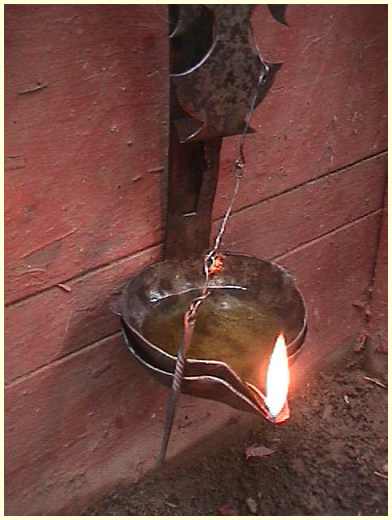
Very fine Antique Crusie Collected in Maine
A jewel in the crown of the Boyle Lighting Collection.
Here we have a very elaborate American Crusie that must have burned fish oil or fat trimmings. It is most similar to ones documented by Isabel Grant in her book Highland Folkways which makes me wonder if this was fashioned by Scottish tinsmiths in America or even brought over from Scotland. The wicks used most often were made of twisted cloth. The wicks at times drew up oil quicker than it could be burned on these lamps allowing the surplus to spill over the sides of the lamp. Because of this problem most grease lamps were fitted with two pans this way so that the second pan could catch the drippings and keep them from over flowing onto the floor. The crusie required constant attention as the wicks were free floating in a spout but still often fell below the surface of the fat and had to be picked back out or adjusted with a pick-wick. This lamp's pick is on a primitive chain that is original but the pick itself I had made to replace the one missing from this lamp. The rooster motif on this lamp is one that is carried though many decorative, antique lamps. This fancy urn pattern with branching leaves is quite elaborate and makes this lamp more valuable. The craftsmanship in this piece is amazing. It still hangs from its original hook and the lamp has no rust or damage at all. The iron hook itself is beautifully forged of square stock and has a decorative twist.
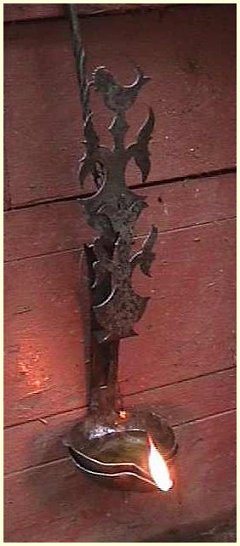
Ancient Roman soothsayers hailed the rooster as an entity that walked the line between light and darkness, between this world and the other. Latter in Europe the rooster or cock became a highly regarded Christian image, during the Middle Ages and it is during those dark decades that the rooster became a popular figure to be placed upon weather vanes, towers, and many other smaller objects. The cock frequently appeared on lamps, candleholders and other household items related to light and fire. The rooster looked always toward eternity to greet the Sun (i.e., Christ) as it rose in the East. The memory that it had been the crowing of the cock that reminded Peter he had betrayed his Lord three times contributed greatly to the symbol of the rooster as one ever vigilant to the subtle presence of evil.
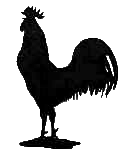
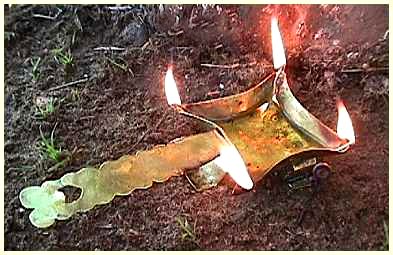
A period brass grease lamp from Scandinavia
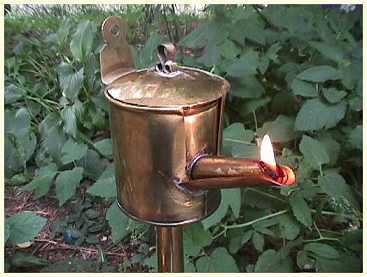
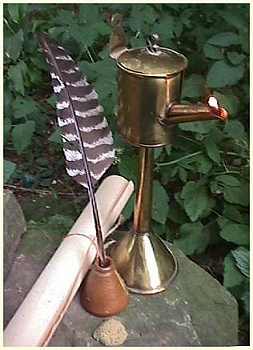
Brass Oil lamp with sand weighted base.This is more than likely a reproduction although a good one.
Oil lamps for the table or desk like this one work very much like the crusie lamp. The wicks often draw up oil quicker than it can be burned, allowing the surplus to spill over so second pan directly under the first on this type lamp catches the drippings. This model can burn longer than a Crusie because it has a larger, covered, oil reservoir. Excess oil runs down the spout and is captured in the second reservoir and can be recycled by pouring it back into the removable lidded pot to be burned latter. The sand weighted base and the tight fitting lid make this lamp much safer and cleaner to use than many grease lamps. This one is fashioned of brass but these lamps were also frequently made of tin. This lamp has a nice little brass tab with a hole drilled in it on the back so it can also be mounted on a wall. Like a betty lamp, this lamp can burn whale oil, fish oil, or animal fat. I use an ultra pure petroleum based, lamp oil in this quite often but obviously that was not available in early America. Lamps like this one are pictured in many early Flemish paintings which has led some to call this type of grease lamp a "Dutch Lamp". They were however not unique to the Netherlands.
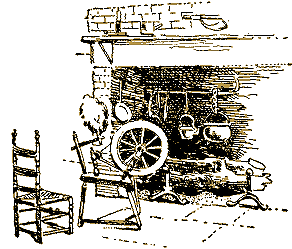
No part of this website may be used for any purpose ( including using images )
without written consent from The Rams Horn


